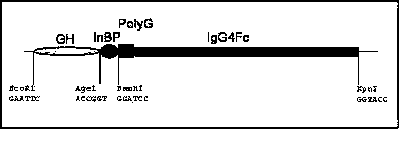Insulin bio-sensitizer and application thereof
An insulin and sensitizer technology, applied in the field of insulin biosensitizers, drugs, and peptides that increase insulin sensitivity, can solve problems such as aggravating insulin resistance, aggravating diabetes and its complications, and achieve regulation of lipid metabolism. Effects of disorders, blood pressure lowering vascular endothelial function, and delaying the time of complications
- Summary
- Abstract
- Description
- Claims
- Application Information
AI Technical Summary
Problems solved by technology
Method used
Image
Examples
Embodiment 1
[0051] Example 1 Expression of Trypsin Fusion Protein
[0052] 1) Construction of hGH-InBP-polyG-IgG4Fc integration plasmid
[0053] Mammalian expression system of fusion protein expressed by fusion of human growth hormone secretory peptide-insulin high-affinity binding sequence-glycine-rich sequence (PolyG)-Fc fragment of human immunoglobulin 4.
[0054] First, the forward chain hGH-F and reverse co-adjuvant chain hGH-R of human growth hormone secretory peptide were synthesized in vitro.
[0055] hGH-F:
[0056] GCGGAATTCACCATGCCACTCTGGGTGTTCTTCTTTGTGATCCTCACCCTCAGCAACAGCTCCCACTGCTCCACCGGT.
[0057] hGH-R:
[0058] ACCGGTGGAGCAGTGGGAGCTGTTGCTGAGGGTGAGGATCACAAAGAAGAACACCCAGAGTGGCATGGTGAATTCCGC.
[0059] Secondly, the forward chain InBP-F and the reverse complementary chain InBP-R of the insulin high-affinity binding sequence were designed. The two pairs of repeated oligonucleotides were annealed and phosphorylated in vitro, and polyG three fragments were ligated into ...
Embodiment 2
[0071] Example 2 Establishment of Trysin Stable Expression Cell Line
[0072] In order to obtain a cell line stably expressing trypsin (InSA) fusion protein, in this example, the constructed integration plasmid p208-InSA was firstly transfected into CHO-K1 cells (purchased from ATCC). Mammalian cells CHO-K1 cells in 35 mm cell culture plates in complete medium (DMEM) at 37 °C and 5% CO 2 Incubate overnight. Using Lipofectamine 2000 (purchased from Invitrogen) transfection reagent, p208-InSA plasmid DNA was transfected into CHO-K1 cells. 24 hours after transfection, cells were transferred to 100 mm culture plates and cultured for another 24 hours. Then, the medium was replaced with G418 (1000 μg / mL) selection medium. After the cells in the control group had no viable cells, they were replaced with low G418 (100 μg / mL) medium. Cell clones were carefully picked after maintaining the culture for 2-4 weeks. After the cells were cultured in the 12-well plate for 4 weeks, 1 μL...
Embodiment 3
[0073] Example 3 Amplified preparation method of trypsin fusion protein
[0074] The screened stable and high-expression cell lines continued to be scaled up until they were placed in 10 cm culture dishes. Store in liquid nitrogen and -80°C separately, and then scale up the culture until the 10cm culture dish is 100% confluent. Then, divide the cells so that 1 x 10 6 / mL density into a 250 mL roller bottle culture flask at 37°C, 5% CO 2 , cultivated at 120 rpm. When the cell density reaches 6×10 6 After / mL, the cells were transferred to 1L roller bottle culture flasks, and cultured under the same conditions until the cells no longer grew significantly (about a week). The cell suspension was centrifuged at low temperature, and the cell culture supernatant was retained for identification by SDS-PAGE and Western blot analysis. At the same time, the cell culture supernatant was freeze-dried and stored at -80°C.
PUM
 Login to View More
Login to View More Abstract
Description
Claims
Application Information
 Login to View More
Login to View More - R&D Engineer
- R&D Manager
- IP Professional
- Industry Leading Data Capabilities
- Powerful AI technology
- Patent DNA Extraction
Browse by: Latest US Patents, China's latest patents, Technical Efficacy Thesaurus, Application Domain, Technology Topic, Popular Technical Reports.
© 2024 PatSnap. All rights reserved.Legal|Privacy policy|Modern Slavery Act Transparency Statement|Sitemap|About US| Contact US: help@patsnap.com










